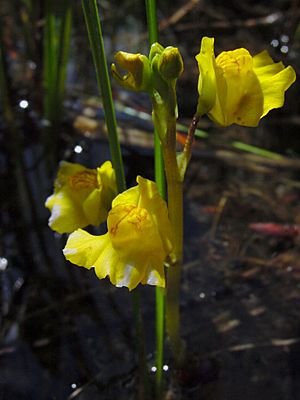Common bladderwort facts for kids
Quick facts for kids Common bladderwort |
|
|---|---|
 |
|
| Scientific classification | |
| Genus: |
Utricularia
|
| Species: |
macrorhiza
|
| Synonyms | |
|
|
The common bladderwort, also known as Utricularia macrorhiza, is a very interesting plant. It is a perennial plant, meaning it lives for more than two years. This plant floats in water and is a carnivorous plant. This means it catches and eats small living things. The common bladderwort belongs to a group of plants called Utricularia. You can find U. macrorhiza in North America and in eastern parts of Asia.
Contents
About the Common Bladderwort
What Does It Look Like?
The common bladderwort is a plant that floats freely in water. It has bright yellow flowers that are quite large. These flowers have a special shape, with two sides that are the same. You can usually see these flowers in the summer months, like June, July, and August. Each plant can have anywhere from six to twenty flowers on an upright stem. One way to tell U. macrorhiza apart from other similar plants is its flowers. They are bigger than the flowers found on any other bladderwort species.
How It Catches Food
The common bladderwort gets its name from tiny "bladders" it has. These bladders are like small traps. The plant uses them to catch and eat tiny creatures. When a small organism brushes against special hairs on the bladder's opening, it triggers the trap. The opening quickly snaps inward. This creates a rush of water that pulls the prey right into the bladder.
The opening closes immediately after the prey is inside. This whole process happens incredibly fast, in just 0.002 seconds! Once the prey is trapped, the plant uses special chemicals called enzymes to digest it. If a larger creature gets stuck in the opening, the plant will slowly digest it bit by bit until the opening can close completely again.
Where It Lives
Its Home in North America
In North America, you can find U. macrorhiza all across the United States and Canada. It mostly lives in ponds and lakes. However, it can also be found in rivers and streams where the water moves slowly. In the northern parts of its range, it shares its habitat with a similar plant called U. minor, which is also known as the lesser bladderwort.

